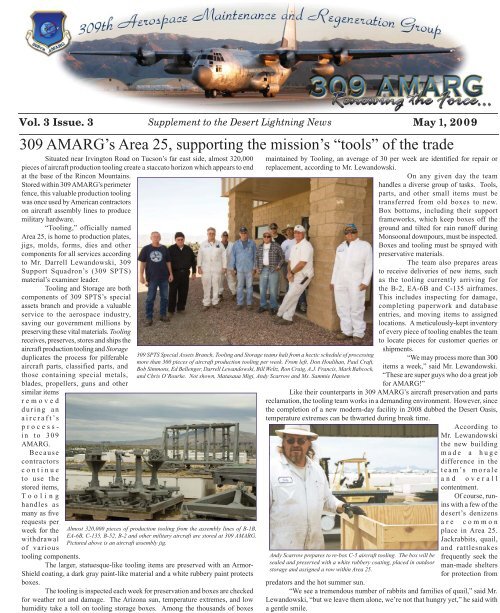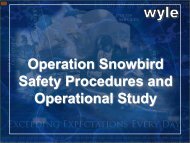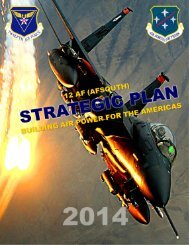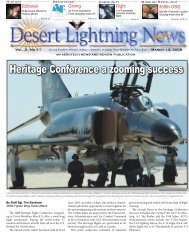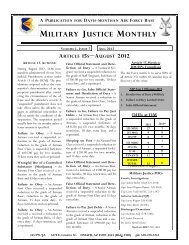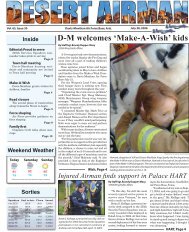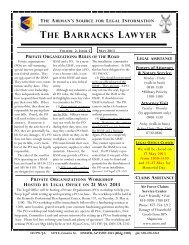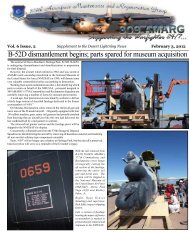AMARG 309 Supplement Mayl 2009.indd - Davis-Monthan Air Force ...
AMARG 309 Supplement Mayl 2009.indd - Davis-Monthan Air Force ...
AMARG 309 Supplement Mayl 2009.indd - Davis-Monthan Air Force ...
Create successful ePaper yourself
Turn your PDF publications into a flip-book with our unique Google optimized e-Paper software.
Vol. 3 Issue. 3 <strong>Supplement</strong> to the Desert Lightning News<br />
May 1, 2009<br />
<strong>309</strong> <strong>AMARG</strong>’s Area 25, supporting the mission’s “tools” of the trade<br />
Situated near Irvington Road on Tucson’s far east side, almost 320,000<br />
pieces of aircraft production tooling create a staccato horizon which appears to end<br />
at the base of the Rincon Mountains.<br />
Stored within <strong>309</strong> <strong>AMARG</strong>’s perimeter<br />
fence, this valuable production tooling<br />
was once used by American contractors<br />
on aircraft assembly lines to produce<br />
military hardware.<br />
“Tooling,” officially named<br />
Area 25, is home to production plates,<br />
jigs, molds, forms, dies and other<br />
components for all services according<br />
to Mr. Darrell Lewandowski, <strong>309</strong><br />
Support Squadron’s (<strong>309</strong> SPTS)<br />
material’s examiner leader.<br />
Tooling and Storage are both<br />
components of <strong>309</strong> SPTS’s special<br />
assets branch and provide a valuable<br />
service to the aerospace industry,<br />
saving our government millions by<br />
preserving these vital materials. Tooling<br />
receives, preserves, stores and ships the<br />
aircraft production tooling and Storage<br />
duplicates the process for pilferable<br />
aircraft parts, classified parts, and<br />
those containing special metals,<br />
blades, propellers, guns and other<br />
similar items<br />
removed<br />
during an<br />
aircraft’s<br />
processin<br />
to <strong>309</strong><br />
<strong>AMARG</strong>.<br />
Because<br />
contractors<br />
continue<br />
to use the<br />
stored items,<br />
Tooling<br />
handles as<br />
many as five<br />
requests per<br />
week for the<br />
withdrawal<br />
of various<br />
tooling components.<br />
<strong>309</strong> SPTS Special Assets Branch, Tooling and Storage teams halt from a hectic schedule of processing<br />
more than 300 pieces of aircraft production tooling per week. From left, Don Houlihan, Paul Craft,<br />
Bob Simmons, Ed Bellenger, Darrell Lewandowski, Bill Weltz, Ron Craig, A.J. Francis, Mark Babcock,<br />
and Chris O’Rourke. Not shown, Matasaua Migi, Andy Scarrow and Ms. Sammie Hansen<br />
Almost 320,000 pieces of production tooling from the assembly lines of B-1B,<br />
EA-6B, C-135, B-52, B-2 and other military aircraft are stored at <strong>309</strong> <strong>AMARG</strong>.<br />
Pictured above is an aircraft assembly jig.<br />
The larger, statuesque-like tooling items are preserved with an Armor-<br />
Shield coating, a dark gray paint-like material and a white rubbery paint protects<br />
boxes.<br />
The tooling is inspected each week for preservation and boxes are checked<br />
for weather rot and damage. The Arizona sun, temperature extremes, and low<br />
humidity take a toll on tooling storage boxes. Among the thousands of boxes<br />
maintained by Tooling, an average of 30 per week are identified for repair or<br />
replacement, according to Mr. Lewandowski.<br />
On any given day the team<br />
handles a diverse group of tasks. Tools,<br />
parts, and other small items must be<br />
transferred from old boxes to new.<br />
Box bottoms, including their support<br />
frameworks, which keep boxes off the<br />
ground and tilted for rain runoff during<br />
Monsoonal downpours, must be inspected.<br />
Boxes and tooling must be sprayed with<br />
preservative materials.<br />
The team also prepares areas<br />
to receive deliveries of new items, such<br />
as the tooling currently arriving for<br />
the B-2, EA-6B and C-135 airframes.<br />
This includes inspecting for damage,<br />
completing paperwork and database<br />
entries, and moving items to assigned<br />
locations. A meticulously-kept inventory<br />
of every piece of tooling enables the team<br />
to locate pieces for customer queries or<br />
shipments.<br />
“We may process more than 300<br />
items a week,” said Mr. Lewandowski.<br />
“These are super guys who do a great job<br />
for <strong>AMARG</strong>!”<br />
Like their counterparts in <strong>309</strong> <strong>AMARG</strong>’s aircraft preservation and parts<br />
reclamation, the tooling team works in a demanding environment. However, since<br />
the completion of a new modern-day facility in 2008 dubbed the Desert Oasis,<br />
temperature extremes can be thwarted during break time.<br />
According to<br />
Mr. Lewandowski<br />
the new building<br />
made a huge<br />
difference in the<br />
team’s morale<br />
Andy Scarrow prepares to re-box C-5 aircraft tooling. The box will be<br />
sealed and preserved with a white rubbery coating, placed in outdoor<br />
storage and assigned a row within Area 25.<br />
and overall<br />
contentment.<br />
Of course, runins<br />
with a few of the<br />
desert’s denizens<br />
are common<br />
place in Area 25.<br />
Jackrabbits, quail,<br />
and rattlesnakes<br />
frequently seek the<br />
man-made shelters<br />
for protection from<br />
predators and the hot summer sun.<br />
“We see a tremendous number of rabbits and families of quail,” said Mr.<br />
Lewandowski, “but we leave them alone, we’re not that hungry yet,” he said with<br />
a gentle smile.
2 May 1, 2009<br />
<strong>309</strong> <strong>AMARG</strong><br />
History Channel episode depicts <strong>309</strong> <strong>AMARG</strong> in a “Life After People”<br />
A film crew from Flight 33 Productions visited<br />
<strong>309</strong> <strong>AMARG</strong> on April 10 to film an episode for The<br />
History Channel’s new Life After People television<br />
series. In keeping with the original pilot aired in 2008,<br />
Life After People explores how cities and landscapes<br />
might change over the course of time if there were no<br />
people.<br />
This particular episode featuring the <strong>309</strong><br />
<strong>AMARG</strong> is scheduled to air next month. It will<br />
explain the preservation processes aircraft undergo<br />
at <strong>309</strong> <strong>AMARG</strong> in order to<br />
endure the extreme desert<br />
temperatures and other<br />
naturally-occurring elements<br />
unleashed by mother nature<br />
during storage.<br />
“A lot goes into<br />
preserving these aircraft,”<br />
said Mr. Jack Kruger, Storage<br />
Services Flight Chief, 578th<br />
Storage & Disposal Squadron<br />
(578 SDS).<br />
“Arriving aircraft<br />
must have their egress systems<br />
made safe, fuel removed,<br />
engines and fuel systems<br />
preserved and a complete<br />
wash and corrosion inspection<br />
before being sealed up and<br />
parked,” he said.<br />
Sealing consists of different stages. A black<br />
electrician-type tape covers crevices and joints and a<br />
barrier material is applied to engine inlets, exhausts and<br />
sensitive areas to keep out birds and rodents. Radomes,<br />
de-icer boots and canopies are waxed to keep the<br />
preservation material from adhering to surfaces.<br />
“After taping, technicians apply two coats<br />
of black Spraylat (both the name of the company<br />
and the preservative compound) to seal the aircraft,<br />
said Mr. Kruger. “Finally, a couple of coats of white<br />
Flight 33 Productions director, Mr. Savas Georgales (l) interviews i Mr. Jack Kruger on <strong>AMARG</strong>’s<br />
unique aircraft storage processes for a June 2009 episode of The History Channel’s “Life<br />
After People..” Right, Mr. Dave Roe, <strong>AMARG</strong>’s senior engineer, describes nature’s impact<br />
on aircraft in a “Life After People” scenario.<br />
Advertising<br />
Spraylat, the visible coating seen on the aircraft from<br />
the perimeter fence, is applied to keep the airframe’s<br />
interior temperatures within 10 to 15 degrees of<br />
ambient temp.”<br />
With the assistance of computer-generated<br />
imagery (CGI), the producers will attempt to depict<br />
what would happen to these aircraft if humankind were<br />
to disappear from the Earth.<br />
However according to Mr. Kruger, the show’s<br />
CGI, which rapidly deteriorates objects exposed to the<br />
elements, is not going to be an easy undertaking due<br />
the amount of effort <strong>AMARG</strong> teams put into preserving<br />
these aircraft to ensure they are ready when operational<br />
forces call them back.<br />
— Lt. Col. Theodore A. Coiner
<strong>309</strong> <strong>AMARG</strong> May 1, 2009<br />
Security matters at <strong>309</strong> <strong>AMARG</strong><br />
Security issues surround us. We hear it over the<br />
airwaves, and it jumps out at us from daily newspaper<br />
headlines. We’re a society focused on<br />
the security of our personal data, our<br />
families, our workplace, our economy,<br />
and our nation.<br />
Fortunately, <strong>309</strong> <strong>AMARG</strong><br />
has a Security Team who are extremely<br />
dedicated and take the demand of their<br />
jobs very seriously, helping to keep<br />
those security stressors at bay.<br />
“Most people view the<br />
Security Office as the place you go<br />
to get your <strong>AMARG</strong> Badge so you<br />
can enter <strong>AMARG</strong> to do your official<br />
work,” said Dr. David Muhleman,<br />
Chief of Security for the Group.<br />
In fact, there is a great deal<br />
more to security than the dozens of<br />
security badges they must research,<br />
prepare, and verify on a daily basis.<br />
The three-member security team faces<br />
a daunting task, 12 miles of perimeter<br />
fence line, 2,600 acres, security for<br />
the almost 700 civilian, military and contractor employees,<br />
and the responsibility for safeguarding more than $35<br />
billion worth of Department of Defense aerospace<br />
assets.<br />
Another challenge, according to Dr. Muhleman,<br />
has been processing and managing hundreds of personnel<br />
security clearances, clearances required to retain<br />
government employment with the Group. The Security<br />
team coordinates schedules across the spectrum<br />
of the <strong>309</strong> <strong>AMARG</strong><br />
workforce from office<br />
and administrative staff<br />
members to mechanics<br />
and technicians<br />
operating in the field.<br />
Their diligence in this<br />
area ensures that many<br />
Group employees<br />
remain on the job with<br />
valid and up-to-date<br />
security clearances.<br />
The world is<br />
a dangerous place with<br />
people ready, willing<br />
and able to cause harm<br />
to the United States.<br />
As the world continues<br />
to ramp up its focus on<br />
ways to counter these<br />
threats, the Security<br />
Team’s myriad internal<br />
programs (information security, operations security, and<br />
anti-terrorism) will follow suit.<br />
“We go to great lengths to assure the protection,<br />
at the correct level, of classified materials that may be<br />
associated with arriving aircraft,” Dr. Muhleman said.<br />
He also noted that although classified material requires<br />
specific, mandatory protective measures, organizations<br />
<strong>309</strong> <strong>AMARG</strong> Security personnel safeguarding $35 billion<br />
worth of Department of Defense aerospace assets and the<br />
people, equipment, and information of <strong>AMARG</strong>. From left,<br />
Security Managers Bryan Downing and Shirley Longoria,<br />
and Dr. David Muhleman, Chief of <strong>309</strong> <strong>AMARG</strong> Security<br />
3<br />
hostile to the United States, including both foreign<br />
governments as well as non-governmental organizations,<br />
are willing to go to great lengths to acquire information<br />
they can use against us.<br />
“If people think that sounds paranoid,” Dr.<br />
Muhleman said, “take a look at the number of computer<br />
hackers, identity thieves, criminals and terrorists we<br />
hear about in the news on a daily basis. Compare that<br />
to the amount of information publicly available, because<br />
of our free country, and you’ll have some idea of the<br />
challenge. Operational security – protecting those pieces<br />
of information that might be put together to give our<br />
adversaries information they can use against us – is a<br />
huge deal.”<br />
“Security of our <strong>309</strong> <strong>AMARG</strong> team is one or<br />
our highest priorities,” said Dr. Muhleman. Whether<br />
monitoring the perimeter for potential trespassers,<br />
interacting with members of the public who request<br />
entry to the facility, or preparing Group employees for<br />
foreign travel, “The <strong>309</strong> <strong>AMARG</strong> Security Office is here<br />
to protect our most valuable assets; our people.”<br />
“We’re happy to be the place where you go to<br />
get your <strong>309</strong> <strong>AMARG</strong> badge,” Dr. Muhleman said. “But<br />
the mission of the <strong>AMARG</strong> Security Office is to “secure<br />
and protect” the people, the equipment/information, and<br />
the mission of <strong>AMARG</strong>.<br />
Their seamless efforts on our behalf, often<br />
“under the radar,” make the <strong>309</strong> <strong>AMARG</strong> Security Team<br />
worthy of the title, Unsung Heroes.<br />
Advertising
4 May 1, 2009<br />
<strong>309</strong> <strong>AMARG</strong><br />
Advertising


